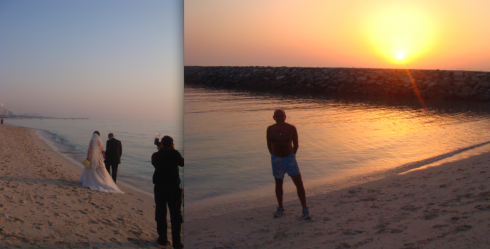Updated Wednesday, May 27, Frankfurt at 06:13


Because of technical difficulties, we could not upload visual images for this posting yesterday in Dubai. Now things are working fine again, so we will keep this posting through tomorrow, when we profile Syracuse University’s Newhouse School of Public Communications.
Our first conversation today is with Jeremy Gilbert, assistant professor at the Medill School, perhaps one of the most innovative of the big journalism schools in the United States.
Mario: How is Northwestern University preparing students to perform well in a multi-platform media world?
Jeremy Gilbert:
Medill is very dedicated to teaching storytelling across all platforms. Part of the new curriculum that is phasing in is the principle that any journalist should be prepared to tell a story on any platform. The old silos of print vs broadcast vs radio vs online are meaningless. Our introductory level journalism classes teach students how to write, record/edit edit video and audio and how to think about using online platforms to tell and share their stories. I teach classes that focus on using multimedia (still images, video, audio and text) to tell stories online.
Mario: How important is having the right technology to teach a multi-platform course?
We use existing Web 2.0 tools as well as HTML, CSS, Flash to tell these stories online. I also lead project classes that seek to stretch the current limits of storytelling by employing new forms of stories or by creating tools to help in story creation or consumption. I would like to think that Medill teaches students that there is a form, means and place for virtually every story they can imagine.
Mario: Medill is a journalism school with a good tradition of quality teaching. How difficult is it to effect change in such enviironment?
The key to the curriculum changes has been to preserve the fundamental journalistic skills that have always been taught at Medill—like writing, reporting and ethics—while still making time to teach new methods of conceiving and telling stories. As a teacher I hope to prepare the students for a career of constant learning and change. I cannot imagine that any of the students will spend their careers in a single newsroom—many may practice journalism but never even work in a newspaper newsroom. So while Medill is teaching specific skills and techniques we cannot give students the impression that those skills are the only ones they will need to learn as journalists.
Mario: Where do you think the good role models are? Who do you seek inspiration from?
Some of the best innovations in storytelling are coming from independent minded journalists like Brian Storm (http://www.mediastorm.org/), Jonathan Harris (http://www.number27.org/) and Adrian Holovaty (http://www.everyblock.com/). Rather than approach storytelling as a dying craft, each of these journalists have looked at the current situation in news and saw instead the opportunity to take advantage of new tools and opportunities to create different kinds of storytelling. I also think that the Knight News Challenge (www.newschallenge.org), the X Prize Foundation (http://www.xprize.org/) are great models for journalism schools. Properly motivated, creativity abounds and journalism schools are uniquely suited to cultivate, harness and disseminate the imaginative work of their students and faculty. In just my first year at Medill I have worked with students on three really exciting project classes: NewsMixer (http://newsmixer.us/), OurFirst Loves (http://www.ourfirstloves.com/) and the 2009 Spring Innovation Capstone (http://www.writeclick.org/) all of which benefitted from the resources and collaboration that a research university, like Northwestern can supply.
University of Miami: “thinking of the story holistically”

We communicate with Sig Splichal ,Program Director, Undergraduate and Graduate Journalism, at the University of Miami:
Mario: what changes are taking place at the University of Miami to prepare students in multiplatform storytelling?
Prof. Splichal:
In addition to the usual writing/reporting/editing classes, we’ve always required our students to take design and photography so they know how information is presented and understand the relationship between words and photos, recognizing that effective communication has different and complementary components.
We’re replacing those design/photo courses with courses that deal with sound, still and moving images, and web-based presentation. The goal is to introduce multi-media gathering skills early in the curriculum so students move through their journalism classes thinking of the “story” holistically.
Mario: Any specific courses to advance this concept?
For some time, we’ve had a web journalism course that has tracked the evolution of newspaper websites. We’ve also introduced a capstone course titled In-depth Reporting and Convergence, which attempts to combine the rigors of in-depth investigation with multi-platform delivery of complex information.
Mario: Where do you think the good role models are? Who do you seek inspiration from?
In my view, the best way to embrace the new reality is to structure reporting/presentation classes around a convergent news operation, where sophisticated gathering and analysis of information (in all forms) occurs and then the information is tailored for different purposes – newspapers, magazines, web, ration and television.
A lazy afternoon at the beach


The camels wore torn-out ancient Arab tunics, the bride wore white, and I wore my comfortable blue swimsuit.
It was a rare totally lazy afternoon for me at the beach in Dubai. I had completed meetings in the morning, and had a five-hour window of sun and beach opportunity till the next meeting, scheduled for the evening, just before I flew out of Dubai.
So, like the tropical person and beach lover that I am, I decided to park myself right on the hot sands of the Arabian Gulf and wait for the very hot (47C, over 90F) temperatures to cool off slightly to go for a run up and down the beach, which I did (and it never truly cooled down. It is Dubai in early summer, could be August any pleace else).
For days now I have been photographing the camels walking lazily on the edge of the water. Camels don’t necessarily run, unless you go to the Dubai camel races, and maybe you see them there.
These animals prefer to drop themselves to the ground, a choreography of movement. You see long legs that collapse into the sand like those tents that one assembles quickly at the beach or camp. Camels have a peculiar smell, which lingers after they have soon disappeared, sort of like Old Spice, but with worse results.
Camels look at you with eyes that resemble dark plums at the supermarket, waiting to be picked. Except that camels are, by nature, melancholic creatures, I believe. They look totally bored by all that surrounds them, like some people I have known. There is no happiness in a camel’s face. But perhaps they are truly happy inside, they don’t just show it. I know people like that, too——but none of them happen to be Cuban.
Sophia made me do it
During the week, I took several photos of the dromedaries, to send to my grandkids.
My granddaughter Sophia (6), saw the pictures and asked his mom, my daughter Elena, “Why is Abo not riding on the camels?”
Good question, except that I had no inclination whatsoever to do this. Yesterday, my final day in Dubai, and when there were not too many people in sight, I gave a tip to the camel-caretaker and gingerly sat on the one camel that was lying on the ground, while he took my picture.
It was quick. I had the feeling the whole world was watching this grandfather of 10 making a total fool of himself. But, what the heck. These are the things that grandpas do for their grandkids.
I was sweaty from having completed my run on the beach, and while I was posing on one camel, the camel right behind me was licking my sweat with his tongue, which felt pretty much like a thorny rag.
Have you ever been licked by a camel? It ain’t pretty.
I was out of there quickly, happy with my picture, ready to send it to Sophia, to make her proud of her adventurous Abo.
Suddenly, the bride appeared
I was still feeling the tongue of that smelly camel on my back, when, alas, a beautiful bride in her wedding gown, skipping like a bunny rabbit on the hot sand, trying to protect her long silky gown from getting all sandy. The groom followed behind. A very relaxed groom, in his tux, ready for a sunset photo shoot with his bride.
I stopped and congratulated them.
By then, the sun was ready for its splash down into the water, melting like an egg into the very warm waters. I had an innocent passerby take my picture, sort of the old man and the sea.
It was time for me to go, get in a suit, get ready for my meeting.
A lazy afternoon at the beach had turned into an exotic adventure with my precious photo on top of that camel, a good unexpected licking by a second camel, then a bride wearing white and getting ready for her close up.
Afternoons like this don’t come often. One has to enjoy them when they happen.
Life can, indeed, be an adventure sometimes.
Follow the Marios

Two Marios. Two Views.
Follow Mario Jr. and his blog about media analysis, web design and assorted topics related to the current state of our industry.
http://garciainteractive.com/
Visit Mario Sr. daily here, or through TweetsByDesign (www.twitter.com/tweetsbydesign)
:
To read TheRodrigoFino blog, in Spanish, go:
https://garciamedia.com/latinamerica/blog/
TheMarioBlog posting #271